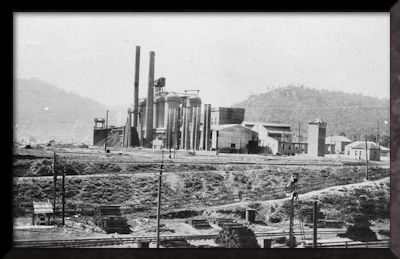|
|
|
|
||||
|
|
DEMOLITION OF BLAST FURNACE BEGUN
The Blast Furnace kept firing and producing at Lithgow, even while Cecil Hoskins was establishing Hoskins’s Iron and Steel’s new venture at Port Kembla. The new plant applied many of the technological lessons learnt at Lithgow and by 1927 it was obvious to all at Lithgow that the plant’s days were numbered. In November 1928 Australian Iron and Steel formed and announced that the Lithgow operations would be shut down. Demolition work began in 1929. By 1932 the works had been dismantled. Many families, including the Mortlocks of Eskbank House, had already transferred to Port Kembla, riding out the Depression down there. Those left behind in Lithgow suffered greatly from the combined effects of the Depression, the contraction of the Small Arms Factory workforce and crises in the coal industry. Although the chimneys had stopped working, a black cloud hovered over the town. To add to the community’s sense of loss, when Australian Iron and Steel left Lithgow it cleaned out everything of value. All the reusable machinery was taken away and the remaining ironwork was scrapped. ‘Possum’, the train in the gardens at Eskbank House, was one of the engines used to pull everything of value down to Port Kembla. Although attempts were made to clear the site, demolishers were unable to put much of a dent in the massive solid structures. They remain standing, in ruins: monuments to loss. What was also in ruins was the reputation of the Hoskins family. Although they invested heavily in the town, and the Hoskins Memorial Institute and Hoskins Memorial Church are valued, the name provokes bitter reactions in the town to this day. Most shocking to the Lithgow Valley, which had lived and breathed with the sirens of the shift changes, was the silence.
Of course it was not the end for Lithgow. The town, and the intricate social and community structures it had developed, was resilient. As gunfire broke out again in Europe the town, which was used to work, was able to mobilise. Men and women worked in the Small Arms Factory for three shifts a day, and the collieries, particularly the State Mine, pulsed with life. Lithgow History Avenue marks the industry that has been lost but, more importantly, it highlights the culture and structures that remain in Lithgow — the life outside the ‘cradle of industry’. SOURCES Ray Christison, ‘Picking up the pieces’ in McKillop, Furnace, Fire and Forge 2006.
|
|
||||
|
|
|
|


